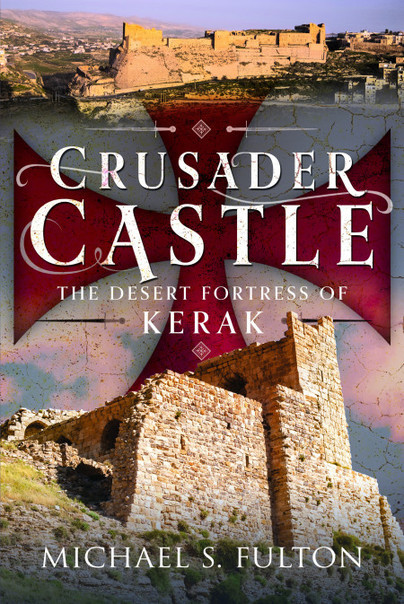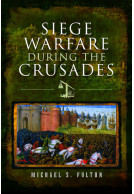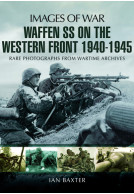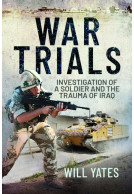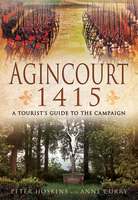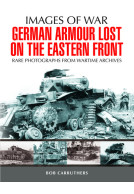Crusader Castle (Hardback)
The Desert Fortress of Kerak
Imprint: Pen & Sword Military
Pages: 272
ISBN: 9781399091268
Published: 19th January 2024
(click here for international delivery rates)
Order within the next 11 hours, 52 minutes to get your order processed the next working day!
Need a currency converter? Check XE.com for live rates
| Other formats available - Buy the Hardback and get the eBook for £1.99! | Price |
|---|---|
| Crusader Castle eBook (58.3 MB) Add to Basket | £6.99 |
The formidable strongholds built by the crusaders are among the most iconic castles of the Middle Ages. These mighty structures offer fascinating insights into the lives of those who built and occupied them, and the role they played in the region’s deep history of conflict. The castle of Kerak, in modern Jordan, is one of the largest, most imposing and best preserved of them all, and Michael Fulton’s detailed, authoritative and highly illustrated account is the ideal guide to it. His close analysis of the fabric of this monumental building, and his description of the centuries of conflict associated with it, make absorbing reading. He takes the reader through the early military history of the castle – from the time it was constructed in the 1140s by Pagan the Butler, through the provocative actions of Reynald of Châtillon and Saladin’s capture of the castle in 1188. He also recounts its later history under Muslim rule, when the castle served as a treasury for the Ayyubid and Mamluk sultans of Egypt. Falling into decline under the Ottomans, Kerak has since regained its importance as a tourist attraction.
A part-by-part examination of the castle and surviving elements of the adjoining medieval town allows readers to appreciate the different stages in the development of this incredible structure and to visualize how it evolved and functioned at different points in time. The detailed architectural guide will be an essential reference for readers who have the opportunity to visit the castle and for those who are keen to gain the best possible understanding of it without going to the site.
An interesting look into an historical castle. Good pictures, lots of information, great for those interested in history, castles, and the crusades.
NetGalley, Aubrey Kerr
This is an interesting read! I am very much interested in crusader and Templar history so this read was very intriguing and informative to me. There is LOTS of information so there’s much to learn! It was well researched and starts you off from its earliest start until the present time. I really enjoyed the read!
NetGalley, Angela Aldridge
Book review available to read at:
Engelsberg Ideas
https://engelsbergideas.com/reviews/in-search-of-kerak-castle/
The castles constructed or rebuilt over the 200 years of the crusader states varied enormously in form and purpose. At one extreme were simple towers which provided basic protection against low-level raids; at the other were flagship castles like Crac des Chevaliers, Belvoir and Montfort, whose remains still resonate over 700 years after the crusaders were driven out of Palestine and Syria.
Chris Marshall
The intensive study of monuments in the Latin East over the past century has been valuable, especially given the noticeable changes in many instances resulting from wear and tear or human actions. Furthermore, the continuing conflict in the Middle East has made it increasingly difficult for tourists or scholars to see the castles and strongpoints firsthand. Studies of castles and strongpoints, like the sites themselves, are diverse. General histories of the crusades inevitably touch on fortifications; specific works like Hugh Kennedy’s "Crusader Castles" or Randall Rogers’ “Latin Siege Warfare in the Twelfth Century” delve into key aspects of the subject; and other works focus on the architectural and archaeological features of individual sites. The most comprehensive castle studies integrate archaeological and architectural analysis with a thorough examination of relevant texts. Scholars like Denys Pringle and the late Ronnie Ellenblum have been instrumental both in developing our understanding of specific sites and in enabling other writers to make more informed generalizations.
Michael Fulton’s new book on Kerak begins by providing us with a highly readable and accessible account of the site's history, ranging from its construction around 1142 by Pagan the Butler to its capture by the Muslims in 1188 and its subsequent roles in the Ayyubid, Mamluk and Ottoman periods. Fulton then offers a detailed architectural examination of the castle by meticulously considering previous scholars’ findings alongside his own investigations. By focusing on an individual site, the author builds on approaches from his earlier book, "Siege Warfare during the Crusades" (2019), combining mastery of sources and deep knowledge of the castle of Kerak to create something that will be valuable not only for academics, but also for general readers interested in medieval history or the Middle East. Fulton wears his learning lightly, and introduces specific aspects of the site's history, like pottery and faunal evidence, in ways that enhance our understanding of day-to-day life at the castle, rather than detracting from it. Similarly, his thorough use of charter evidence (such as a document of November 1177 by which Stephanie of Milly and her famous, indeed notorious husband, Reynald of Châtillon, confirmed grants of property to the Hospitallers) helps make sense of the roles of key individuals and families in Kerak and the surrounding area.
In the thirteenth century, Kerak retained its importance as a key centre of influence in the Transjordan area. Fulton does an excellent job of unravelling the Ayyubid rivalries in the period up to its surrender to the Mamluk sultan Baybars in 1263. He goes on to give us a fascinating account of the site during the Ottoman period, explaining how its significance declined so that eventually, it retained only local importance, increasingly affected by tribal rivalries. By the time that western travellers, including missionaries, began to visit in the early 19th century, Kerak had witnessed a shift towards a semi-nomadic way of life amongst its population. This trend was gradually reversed as settled farming practices developed in the local area in the first half of the 20th century.
Fulton’s description of the castle and town of Kerak is outstanding. Whilst he acknowledges that much of the site still needs to be properly analysed and large parts are inaccessible, he is able to combine the outcomes of previous studies with his own on-site investigations to excellent effect. Again, the text is written in a way that makes it readily accessible, either for a visitor to the castle or for those who simply have an interest in it. The selection of photographs, maps and plans significantly enhances this accessibility. Finally, the very clear notes and bibliography will be welcomed by those who wish to delve deeper into this subject.
This is an important and very well-written book which greatly increases our understanding of the castle of Kerak, its surrounding area and the individuals and groups who contributed to its history.
Rating: 5 out of 5 stars
NetGalley, Kathryn McLeer
This was a really well done history on this Fortress, I never had heard of this before so it was interesting to hear about the history of.
It I felt the author did a great job and explaining the history well and keeping it interesting.
It was a really well done book. And I look forward to reading more from the author.
In this fascinating case study of a medieval castle, Michael Fulton introduces readers to the long history of Kerak, a castle located in what is now Jordan. Tracing its long medieval history, Fulton explores the history of this castle in the context of the Crusades, the Middle Ages, and the longer history of the region. Fulton emphasizes the military history of this castle, given his focus on the Crusades, and does so in a way that feels natural, relevant, and understandable. Bringing in a variety of historical figures to contextualize and expound upon Kerak’s history, Fulton masterfully places this architectural and historical case study into a larger international history framework. Fulton’s prose and organizational structure of this book is particularly well done, focusing on key and minor events in a chronological order. By going beyond the title of the book (and focusing on the Crusades), Fulton includes descriptions of Kerak Castle and its history before and after these main events, expanding the narrative in an incredibly useful way and further contextualizing the history of Kerak Castle. Fulton’s latest book is an excellent historical, architectural, and military case study of a critical location during the Crusades of the Middle Ages in the modern Middle East.
NetGalley, Lily Amidon
Kerak castle is a splendid sight, apparently intact on its high ridge and dominating the country for miles around. Looking westward across the Dead Sea from its lofty baileys you can see (at least on a clear day) Jerusalem, while to the east is the long slope down to the desert. Clustered beyond its great northern wall is the town which is close to the "King's Road" from Amman, to which access was once gained through tunnels, while the "Desert Road" is only a short drive away. Although the focus of this book is the great fortification, Fulton is at pains to point out that the town, itself fortified, is actually older. It lies in a reasonably well watered and fertile area which has been populated since prehistoric times. Its position near the two great roads make it a useful stopping place on the way towards the Gulf of Aqaba.
John France
Although the origins of the great castle are crusader, Fulton is at pains to discuss the whole history of the site down to modern times. Kerak was once under the influence of Petra, about 60 miles to the south. It became Christian in Roman times and, indeed, still has a strong Christian population. But it gained immensely in importance with the coming of Islam for the Haj routes from Syria pass down the "King's Road" and the "Desert Road." However, Kerak looms large in the history books because of its role in the crusades, as Fulton recognises by devoting 84 pages to the "Frankish Period" and only 66 to the Ayyubid, Mamluk and Ottoman eras.
After the First Crusade Fulton observes that the Trans-Jordan (Oultrejordain) was something of a power vacuum with neither Egypt nor Damascus committed to filling it, so the crusaders were able to establish themselves in the area, and in 1115 Baldwin I built the fortress of Montreal (Qal'at ash-Shawbak). Subsequently a number of small lordships arose. It was only about 1142 that Pagan the Butler, for reasons unknown, began to build the castle of Kerak which, in the 1160s, became the centre of a consolidated Lordship of Transjordan. Its emergence was a long and complex affair, to which Fulton provides an excellent guide. But the Oultrejordain remained a relative backwater until the 1170s when Nur ed-Din and Saladin unified Egypt and Syria. The lordship then entered a very short period of great importance. Its military presence, and particularly Kerak, threatened communications between the elements of the new empire. The implicit threat to the Haj undermined its rulers' prestige. And in 1176 its heiress married Reynald of Châtillon whose ferocious reputation shocked the Muslim world. Saladin twice unsuccessfully besieged Kerak which, even after Hattin, held out until 1188 when it became an Ayyubid possession. The town and castle continued to play an important role in the complex politics of the Ayyubid clan until 1263 when the Mamluks seized it. It then really became a backwater, a situation which continued under the Ottomans whose government only became direct when, in the late 19th century, they crushed the local powers into whose hands it had fallen.
At the heart of this book - and this is no fault of the author - is a vacuum, because we know so very little about the castle itself. This is why only a single chapter, of 28 pages, is about its actual fabric. This contains an excellent description and analysis of what can be seen, and Fulton is to be congratulated on incorporating the views of all who have written seriously about it. But the fact is, as he remarks, that 'Much of Kerak still lies underground' (p.179). We know that the north wall, which faces the town, was defended by a deep moat cut right across the salient from cliff to cliff, but this has been filled in. Much demolition has been done at various times on this great wall, and probably much building as well. The question of its great gate, referred to in our sources, is moot. Some visible damage has been attributed to the catapults deployed by Saladin in his sieges, but Fulton is very familiar both with the historical events and the limitations of such equipment, and rightly doubts the validity of such comments.
In the interior of the castle two parallel baileys run most of its length, vast spaces which have never been properly investigated. Underneath them is a network of constructions which have barely been explored. Fulton is familiar with the recent but very limited archaeological work done here. Where he can he indicates what is thought to be Frankish and what later. As one who has visited Kerak and has looked at the reports I am impressed by what he has made of the jumbled confusion only too apparent to the visitor.
We know from the literary sources that in crusader times this was a really formidable castle which defied sieges by Saladin in 1183 and 1184. But what was the crusader castle like, and what was done to it in later centuries? In the absence of serious and sustained archaeological investigation we cannot know, and this is particularly worrying because some recent restoration seems ill-founded. Fulton is rightly sceptical of assumptions, especially that fine stonework was Arabic and rough that of the crusaders. He is very generous to all those who have worked on Kerak, and what he tells us is about as much as we can know. A very worthy part of the book is the chapter on the town of Kerak which is a crowded place that has truly grown over its past.
This is an exceptionally clear and detailed history of Kerak and of the town which is likely will be a standard reference for years to come. The book is amply illustrated with colour photographs which capture the reality and majesty of the place. I picked up a few minor errors: for example, Ibn Shaddad died in 1234 not 1324 (p.3), but these are trivial. This is a very valuable and readable contribution to our knowledge of Kerak, the Transjordan, and their role in the history of the Middle East.
Rating: 5 out of 5 stars
NetGalley, Samantha Santarpia
I found this book to be very informative! It is well-researched and well-written, which is the perfect combination for a book of this nature.
The title, Crusader Castle: The Desert Fortress of Kerak, caught my attention. I found myself intrigued and wanting to learn about this "crusader castle" that I'd never heard of before. If you find yourself similarly interested, I do suggest you give this a read. This book is definitely for anyone with an interest in medieval castles and their history. I also think if you like history in general, or even something more niche like learning about how and why a castle would change over time, this will be an enjoyable read.
I thought Crusader Castle was very comprehensible, and this is coming from someone who, as I said, had very little knowledge on the topic prior to picking up this book. I think what I liked best about this book (besides the fact that I love maps and it does include a couple of very helpful ones) was honestly how well it did at holding my interest. I'm not sure if I'll ever get to visit Kerak in person, but if I do make that trip happen it'll be because of how fascinating I found Dr Fulton's book the entire time I was reading it!
About Dr Michael S Fulton
Michael S. Fulton is a Canadian historian and archaeologist of the crusades. He completed his PhD at Cardiff University in 2016 and has published widely on medieval warfare, fortifications, and the crusades. His books include Artillery in the Era of the Crusades (2018), Siege Warfare during the Crusades (2019), Contest for Egypt (2022), and Crusader Castle: The Desert Fortress of Kerak (2024).







